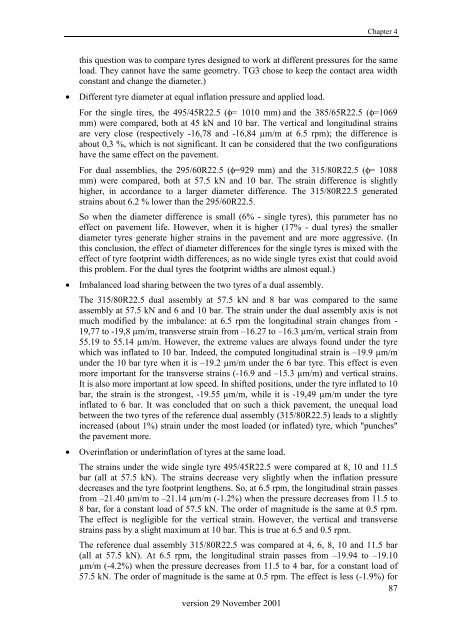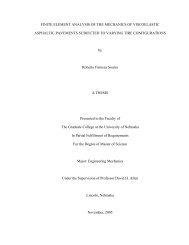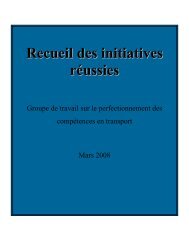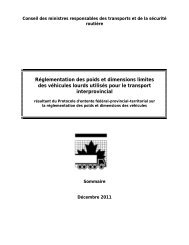You also want an ePaper? Increase the reach of your titles
YUMPU automatically turns print PDFs into web optimized ePapers that Google loves.
Chapter 4this question was to compare tyres designed to work at different pressures for the sameload. They cannot have the same geometry. TG3 chose to keep the contact area widthconstant and change the diameter.)• Different tyre diameter at equal inflation pressure and applied load.For the single tires, the 495/45R22.5 (φ= 1010 mm) and the 385/65R22.5 (φ=1069mm) were compared, both at 45 kN and 10 bar. The vertical and longitudinal strainsare very close (respectively -16,78 and -16,84 µm/m at 6.5 rpm); the difference isabout 0,3 %, which is not significant. It can be considered that the two configurationshave the same effect on the pavement.For dual assemblies, the 295/60R22.5 (φ=929 mm) and the 315/80R22.5 (φ= 1088mm) were compared, both at 57.5 kN and 10 bar. The strain difference is slightlyhigher, in accordance to a larger diameter difference. The 315/80R22.5 generatedstrains about 6.2 % lower than the 295/60R22.5.So when the diameter difference is small (6% - single tyres), this parameter has noeffect on pavement life. However, when it is higher (17% - dual tyres) the smallerdiameter tyres generate higher strains in the pavement and are more aggressive. (Inthis conclusion, the effect of diameter differences for the single tyres is mixed with theeffect of tyre footprint width differences, as no wide single tyres exist that could avoidthis problem. For the dual tyres the footprint widths are almost equal.)• Imbalanced load sharing between the two tyres of a dual assembly.The 315/80R22.5 dual assembly at 57.5 kN and 8 bar was compared to the sameassembly at 57.5 kN and 6 and 10 bar. The strain under the dual assembly axis is notmuch modified by the imbalance: at 6.5 rpm the longitudinal strain changes from -19,77 to -19,8 µm/m, transverse strain from –16.27 to –16.3 µm/m, vertical strain from55.19 to 55.14 µm/m. However, the extreme values are always found under the tyrewhich was inflated to 10 bar. Indeed, the computed longitudinal strain is –19.9 µm/munder the 10 bar tyre when it is –19.2 µm/m under the 6 bar tyre. This effect is evenmore important for the transverse strains (-16.9 and –15.3 µm/m) and vertical strains.It is also more important at low speed. In shifted positions, under the tyre inflated to 10bar, the strain is the strongest, -19.55 µm/m, while it is -19,49 µm/m under the tyreinflated to 6 bar. It was concluded that on such a thick pavement, the unequal loadbetween the two tyres of the reference dual assembly (315/80R22.5) leads to a slightlyincreased (about 1%) strain under the most loaded (or inflated) tyre, which "punches"the pavement more.• Overinflation or underinflation of tyres at the same load.The strains under the wide single tyre 495/45R22.5 were compared at 8, 10 and 11.5bar (all at 57.5 kN). The strains decrease very slightly when the inflation pressuredecreases and the tyre footprint lengthens. So, at 6.5 rpm, the longitudinal strain passesfrom –21.40 µm/m to –21.14 µm/m (-1.2%) when the pressure decreases from 11.5 to8 bar, for a constant load of 57.5 kN. The order of magnitude is the same at 0.5 rpm.The effect is negligible for the vertical strain. However, the vertical and transversestrains pass by a slight maximum at 10 bar. This is true at 6.5 and 0.5 rpm.The reference dual assembly 315/80R22.5 was compared at 4, 6, 8, 10 and 11.5 bar(all at 57.5 kN). At 6.5 rpm, the longitudinal strain passes from –19.94 to –19.10µm/m (-4.2%) when the pressure decreases from 11.5 to 4 bar, for a constant load of57.5 kN. The order of magnitude is the same at 0.5 rpm. The effect is less (-1.9%) for87version 29 November 2001






